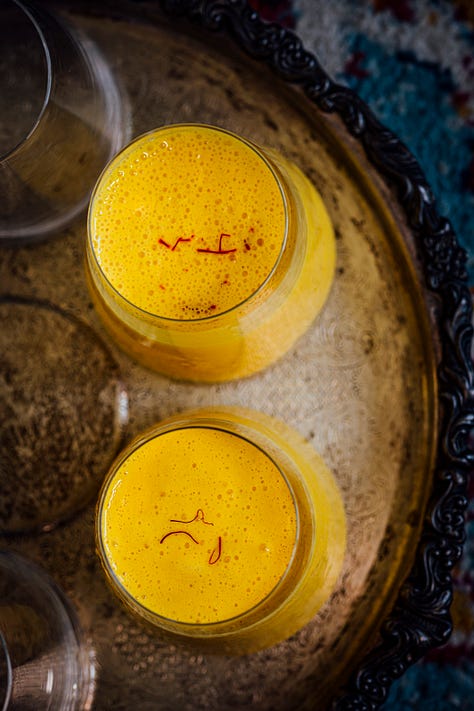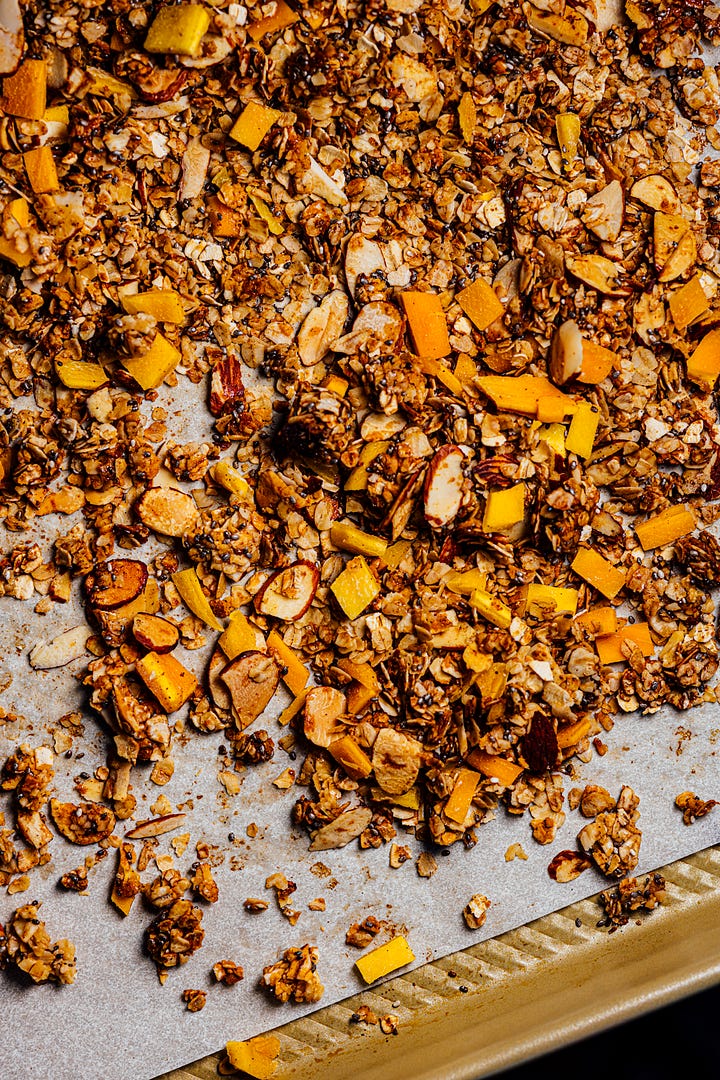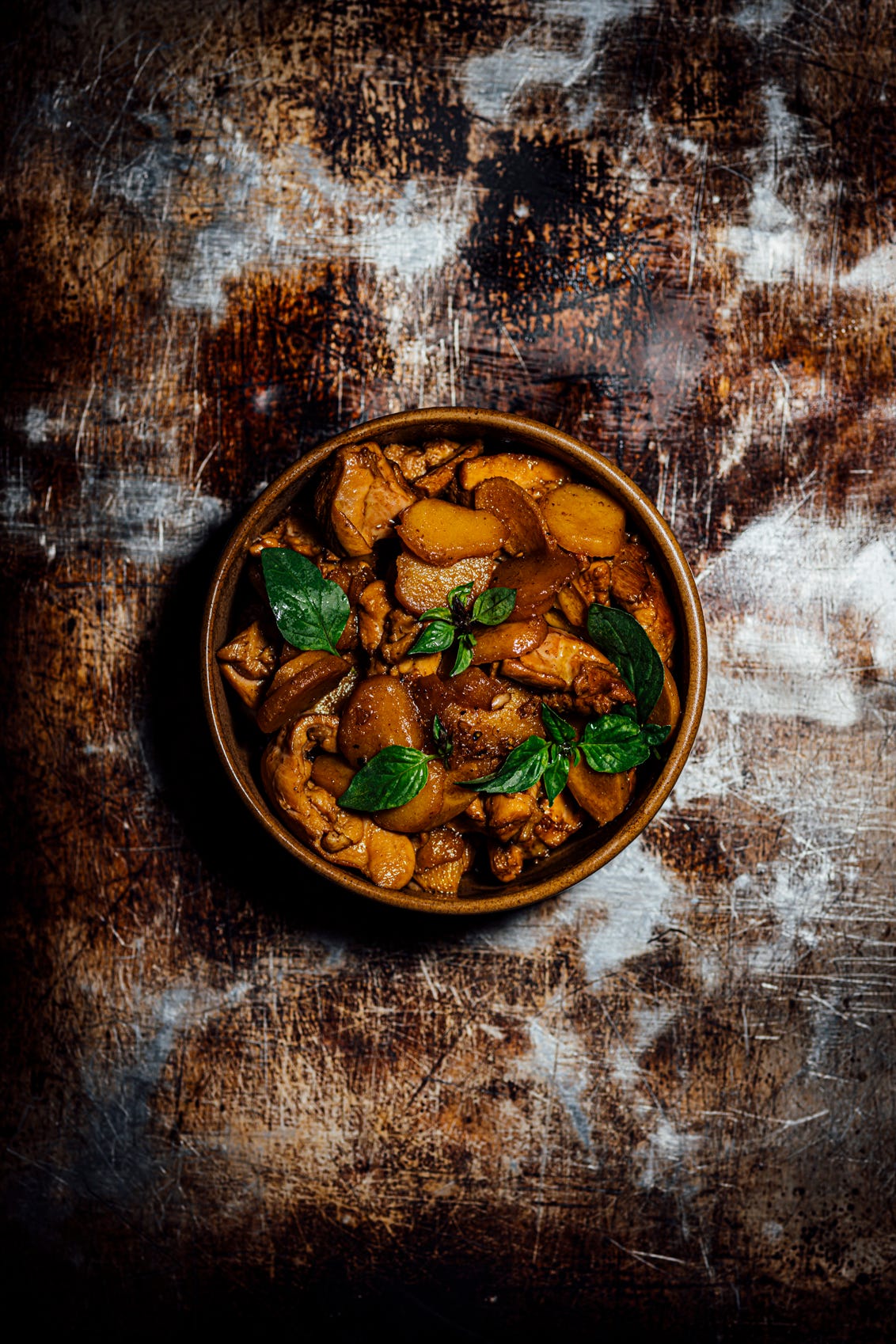🥭 If You Love Mangoes, Then This is For You
Plus how to take care of your wooden kitchen tools
🥭 🥭 🥭 My NEW COOKBOOK, VEG-TABLE, is now named a Best Cookbook of 2023 and is available worldwide! Please check it out, and thank you for your support. If you have a moment to spare, please leave a review for Veg-Table on Amazon, Barnes and Noble, Waterstones, or the many indie bookstores where you purchased the book. Thank you!
Hello!
I’ve spent a wonderful week in Virginia visiting my family. It snowed! It wasn’t a snowstorm, but things got pretty chilly. We ate a lot of good food, including biscuits, and I tried my first honeybun cake (I had no idea what a honeybun was until now and was very surprised to learn that it is honey-free). I didn’t do much and intentionally forced myself to take a break. I’ve got this bad habit of thinking about or trying to work on holidays, and I’m trying to get rid of it. I spent most of my time meeting the new animals on the farm, including Jacob, the new calf my MIL adopted after his mother abandoned him.
April is a special time; it is the month of my birth, and it also kicks off mango season. To many South Asians, including myself, mango season is the short period we look forward to between spring and summer. This week’s newsletter contains a special section on my favorite mango recipes and a few tips for those who want to use them in their recipes.
Thank you, and have a great week,
Nik
A few tickets are left for my book talk in New York City at The James Beard Foundation’s Platform with the brilliant Helen Rosner on April 21st at 4 pm EST. Use the code CHEFAPRIL10 to receive 10% off the tickets. Details, including the menu, are here. I look forward to meeting you in person!
This week’s recipe is the classic Taiwanese San Bei Ji or Three Cup Chicken, which I’ve adapted from Kian Lam Kho’s book Phoenix Claws and Jade Trees. The chicken takes on the fragrance of toasted sesame and fresh Thai basil. Chestnuts aren’t part of the traditional version, but I love them for their crunch. Get the recipe here. Serve it over plain steamed rice.
I’m adding a new section to this newsletter where I will answer
“Food publications often recommend not using spray oils with non-stick cookware. Why is that?”
This is partly true. Not all, but some cooking spray oils contain soy lecithin (you’ll need to check the ingredient list on the can). Soy lecithin is a phospholipid (a fat with phosphate groups, also seen in egg yolks) used as an emulsifying agent in non-stick cooking sprays like PAM. During cooking, the lecithin polymerizes with the oil to form a coating. In stainless steel cookware and white enamel bakeware, you’ll see a brownish film form on the surface, while in non-stick cookware like bundt pans and frying pans, it becomes harder to observe because they’re usually dark. As this polymer film builds up, it destroys the non-stick properties of the non-stick cookware. It’s easier to clean the layer of gunk from a stainless-steel pan because they can handle brute scrubbing and Bar Keepers Friend (I prefer the soft cleanser over the powder as the latter gets into the air). Unfortunately, non-stick cookware is a bit precious, making cleaning difficult. Eventually, food starts to stick to the surface, and the cookware will need replacing. In general, use less cooking oil when using non-stick cookware because it polymerizes and destroys the non-stick coating on the pan. (This is one of several reasons I’m not a fan of non-stick cookware and prefer stainless steel and cast iron.)
🥭 Mango Season is Here!
Mangoes are one of my favorite fruits. If you’ve been following me for a while, you’re probably aware that they play an important part in my life. One day, I might plant an Alphonso mango tree in my backyard to remind me of my grandparent’s trees in Goa, but for now, I’ve got mango cravings to satisfy.
Mango Tips
Not all mangoes are created equally. Their fragrance and taste differ considerably between varieties. I love Alphonso and Kesar varieties for eating and cooking desserts; they function well in both departments. They’ve got a smooth buttery texture. Champagne mangoes from American grocery stores aren’t my favorites; they’re often chalky and fibrous, so I avoid them. Australian mangoes are another delicious group to try; I’ve eaten the Honey Gold and Kensington Pride (they’re unavailable now since the seasons are flipped). When selecting a mango for cooking, ensure it tastes good and has the right flavor and texture. A ripe mango should be so soft and juicy that the pulp should fall apart easily, just like a ripe peach.
I usually get the 24 Mantra Organic Brand if I buy canned mangoes. For fresh Indian mangoes, I hop over to Bhanu’s Indian grocery store in L.A.
Mangoes contain acids, which give them a sour taste. During the fruit’s ripening process, most of the acids are converted to sugar, but a portion remains, leaving a sour taste (the degree of sourness varies by the variety of the fruit and how ripe it is). If the mango is too tart (too acidic), it might curdle the proteins in milk.
Mangoes also contain protein-digesting enzymes that will curdle milk and prevent proteins like gelatin from setting. When using fresh mango pulp or puree, heat it until it simmers for at least 1 minute over medium heat and cool it down before using. The heat will help inactivate the enzymes and won’t affect the quality of the recipe. For example, a mango cheesecake made with gelatin sets correctly when the fresh mango pulp is heated before incorporation because the enzymes won’t cut the gelatin. If you use canned mango pulp, the protein-digesting enzymes won’t be an issue, as the enzymes are inactivated during the canning process.
Mango pulp freezes well. If you have a surplus, extract the pulp and freeze it in airtight, freezer-safe bags or containers for up to 4 to 6 months.





I’ve picked a few mango recipes for you this month. Because it feels like summer in L.A., I’ve got two mango ice creams on the menu for you - an easy four-ingredient mango ice cream that uses kefir and cream cheese and a second one that is flavored with coconut and star anise. Mango lassi in warm weather is another must, and there’s my ultimate mango cardamom cake that contains a layer of mango lime curd that’s coated with mango buttercream frosting using my friend Stella Park/Brave Tart’s buttercream frosting’s recipe. There’s a spiced mango granola recipe for breakfast, but feel free to snack on it all day.
Soak Your Wood To Make It Last Longer
If you own a wooden cutting board, you probably do an excellent job oiling and waxing it. However, we often forget to extend the same care to our wood kitchen tools. I’m guilty of this and learned the hard way. I’d keep my cutting boards shiny year-round while the wooden handles of my silicone spatulas would start to bow over time because I wasn’t oiling them. One of them even cracked. Wood-handled knives, spatulas, spoons, gnocchi, pasta tools, etc., all need some TLC over time. Oil also prevents microbes from growing in the wood and makes them last longer.
Whenever we use wooden tools to prepare and cook food, they’re exposed to moisture, which over time makes the wood warp and, in some instances, even split. I’ve collected several small wooden spoons for my salt cellar and jams from various places, and they are used a lot. If they get damaged, I will be very sad.
How To Oil Wooden Kitchen Tools
An editor once told me to oil my wooden tools once a month, but I have to be honest: I’ve not stuck to the schedule. Instead, I do it once every two or three months. I get a large container of Clark’s Cutting Board Food-Grade Mineral Oil and use it for my wooden cutting boards and kitchen tools. (I like the orange and lemon scent.) Never use cooking-grade oils because, unlike mineral oil, they go rancid, and the wood will rot. Mineral oil will stay good for at least two years once the bottle is opened so that you can get a lot out of it. If you want to avoid mineral oil, Clark’s makes a coconut oil version of the product; I haven’t tried it, so I can’t vouch for it. I do not use wax on my cooking tools (I reserve it only for the cutting boards), but you can use it to add an extra layer of protection.
Before you proceed, make sure the wooden tools are clean and dry. If wet, the water trapped inside the wood will prevent the oil from entering.
Take a large, deep dish or tray, place the wooden tools there, and pour enough food-grade mineral oil to submerge them completely. Cover the tray and let it sit overnight in a cool, dark place.
The following day, flip the tools and repeat the soaking process.
On the third day, remove the tools, drain any excess oil, wipe dry with clean kitchen towels, and put them away. Strain and transfer the extra used oil to a new storage container to avoid mixing it with the fresh oil. I reuse the oil at least six times before getting rid of it. Discard the oil like you would cooking frying oil.
Note: If you’re running low on time, you can soak the wood for 24 hours. Flip them after 12 hours so each side has enough time to absorb the oil.











On the cutting board write-up, an observation and a question.
After seeing a reference to "board cream", I did a bit of research. You can make your own using 1 part beeswax or paraffin to 4 parts food-grade mineral oil. Combine them in a pint canning jar and then place the jar in a pan of simmering water until the wax has melted. Transfer the liquid to a smaller canning jar and seal. (Not seal w/a water bath; just place a lid on top and finger-tighten w/a canning ring.) It doesn't seem to matter whether you use beeswax or paraffin. I currently am using paraffin pellets as they're easy to measure out. And yet another argument for a kitchen scale.
On immersing the wooden tools, it seemed like it might be easier to do it in bag instead of an open container; possibly a Ziploc or silicone bag? You could seal it and just give it a tumble anytime you walked by.
Which then made me think that you could also vacuum-seal it, but then I decided that perhaps it was time to go take a walk outdoors.
I grew up in a household where we had special rules for washing wood or wood-handled cooking tools. They couldn't sit in the dishwater and certainly not go in anything like a dishwasher. I have some grapewood spatulas that I've been using for ~50 years. Do I oil them regularly? No. I do use them when I'm frying tortillas for crisp tacos to hold the bent tortilla shells apart. So the working end is resting in hot oil.
A big Congratulations Nik on Veg-Table being named a Best Cookbook of 2023.